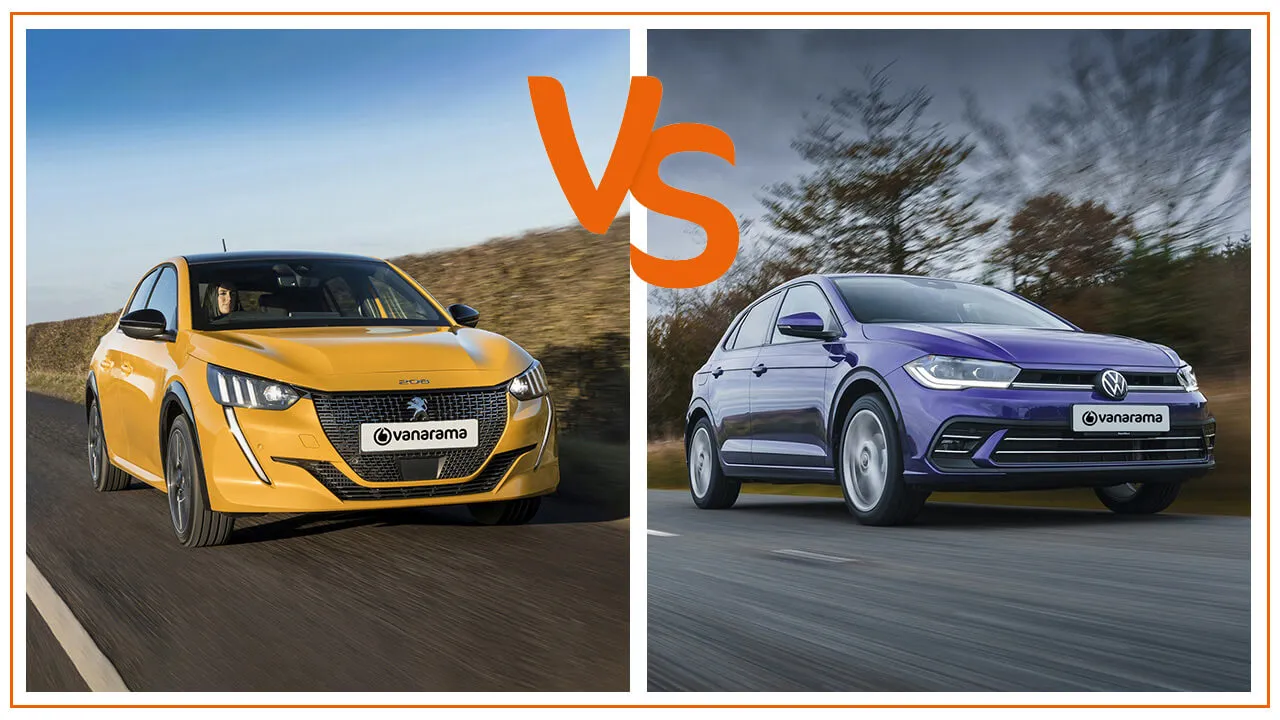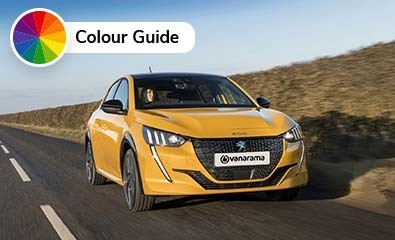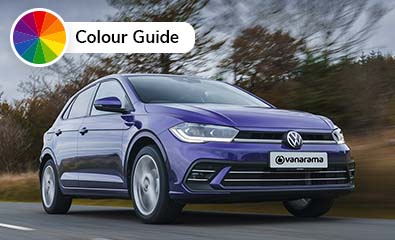It’s a classic North European battle here, with France and Germany squaring up as the striking Peugeot 208 supermini takes on one of its heavyweight rivals in this sector – the long-serving Volkswagen Polo. Time to find out which of these two attractive runarounds is the car for you.
Design Differences
We could say this is a clear case of ‘style v substance’ here, but that would be to denigrate both the Peugeot 208, which is a truly quality item throughout, and the Volkswagen Polo, which is by no means ugly to look at outside or in.
So what we mean really is that the Peugeot, both in terms of the way it looks externally and how unusual its excellent interior is, has an immediate kerbside star quality that the Polo just can’t match. Honestly, the 208 is like a little concept car has escaped from a motorshow and made it into the showrooms. Its sharp, edgy, distinctive styling really comes into its own on higher specifications, where ‘triple-claw’ LED head- and taillights are joined by those big ‘fang’-shaped daytime running lamps, and a contrasting black roof can also be specified for even more aesthetic desirability.
Then you get into the driver’s seat, and you’re presented with a 3D digital instrument cluster mounted up high, a tiny steering wheel sitting below it, and the use of the sort of textures and materials that you’d expect on cars twice the size and plenty of times the cost. It’s a storming little thing, the 208, it really is. You can find out more about available customisations in our 208 colour guide.
The Polo is, of course, no slouch in terms of interior quality – it is a Volkswagen, when all’s said and done – and a midlife model facelift ready for the 2022 model year saw every version bar the basic Life get a snazzy 10.25-inch digital instrument cluster. It’s not 3D and as funky as the Peugeot’s set-up, but it is configurable, and presents its information clearly, concisely and crisply. However, aside from a large dashpad piece of trim, which can be painted bright red in the range-topping GTI, the interior of the VW is sturdy, sensible and safe.
They’re attributes which could be said of the bodywork, too. The aforementioned facelift of the Mk6 Polo at the end of 2021 freshened up the grille and headlights, although the more distinctive change came around the back, where wider light clusters now bleed into the bootlid; previously, they were smaller, squarish lamps to either side of the car. OK, the GTI model looks pretty good, with its big wheels and sporty body kit, and the same can be said to an extent of the R-Line variants too, but overall the Polo is merely only quietly handsome, rather than genuinely knockout like the 208. Check out our Polo colour guide for more details on paint and interior options available.
Driving Differences
The same difference in the levels of subjective sparkle comes in the driving experience too, with these cars’ dynamics reflecting their visual appearances. In essence, if you want a no-nonsense, supremely comfortable and easy-going car, you pick the Polo. Its high-speed refinement makes it feel unflappable on the motorway and the passenger compartment is well isolated from external noises like wind blustering past the A-pillars or the tyres rolling along the road. It is a planted and assured car in many respects, the Volkswagen, and it will fit seamlessly into your life with no dramas whatsoever.
What it lacks for is any real excitement behind the wheel, even as the range-topping 207hp GTI – in fact, that hot-hatch flagship is arguably the most disappointing model of all, as its three-letter badge infers it is going to be something really special to drive. Sadly, it’s not – it’s fine, but rivals in the form of the Ford Fiesta ST and Hyundai i20 N do this sort of pocket-rocket thing much better… and for less cash into the bargain.
Weirdly, while Peugeot has one of the most enviable reputations in the entire industry for doing pint-sized go-faster hatchbacks, such as the legendary 205 GTi, there is no out-and-out performance model of the current 208. Indeed, the most horsepower you’ll get from a conventional model of the French car is 130hp, some way shy of the Polo GTI’s meaty output.
Yet the Peugeot is the better car to drive. It’s not much less comfortable nor refined than the Polo at speed, but it adds in far more driver involvement and fun the rest of the time you’re motoring along in it. Part of the 208’s appeal comes from that tiny button Peugeot sees fit to call a steering wheel, which will make you feel like you’re piloting a go-kart rather than a five-seat, one-tonne-plus hatchback. The Peugeot’s 1.2-litre three-cylinder turbo petrol engine is also more charismatic than the smoother, more subdued 1.0-litre three-pots in the Polo range, although the 1.5-litre turbodiesel 208s are a little noisier to live with. However, in summary the same story as the styling is reflected here – the more exciting car to look at is the more exciting one to drive. And that is clearly the Peugeot 208.
Which Is More Practical?
The Polo is a physically larger car than the 208, albeit only marginally, but that stretched body leads to a touch more room between the axles – called the wheelbase – and that results in improved passenger space in the rear of the vehicle. Not only that, but the Volkswagen has a bigger boot than the Peugeot, with 351-1125 litres on offer depending on how you have the rear seats configured, which compares favourably to the 208’s stats of 311-1106 litres. Bear in mind the sportier exhaust system of the Polo GTI affects this boot-space victory for Germany, though, as it only has 305-1079 litres – less than the Peugeot.
Both cars have useful storage compartments in the cabin, intuitive layouts of their main switchgear and controls, and no major visibility issues when manoeuvring them at low speeds or placing them on the roads at higher pace. However, we’ll give the nod to the Polo in this section, because not only is it bigger, its plainer driving position and instrument cluster/wheel set-up will suit a wider range of driver shapes than the 208’s will. The very thing that is one of the Peugeot’s strong points – that funky i-Cockpit dashboard layout – does count against it here, as some people report that no matter how they adjust the seat and the tiny steering wheel, they still can’t see the information presented on the instrument cluster array behind it.
Running Costs Comparison
As both cars are small, compact, light superminis with modest-sized engines (in the main), then neither is going to be ruinously expensive to run. Both the Polo and the 208 ranges kick off with normally aspirated – that is to say, they don’t have turbochargers – petrol engines. The Volkswagen’s entry is an 80hp/93Nm engine called the MPI 80, while Peugeot offers a 75hp/118Nm 1.2-litre PureTech.
You’re better off going for the turbocharged cars in each range, though, as they offer much more torque – making them easier to drive in a wide variety of situations – and they actually prove to be more economical than the non-turbo engines. For the Volkswagen, any 1.0-litre Polo will return anything between 50.4- and 54.3mpg of combined fuel economy, with CO2 outputs of 118-128g/km accordingly. Over in the 208’s world, its petrols will give back between 44.3- and 56.7mpg.
Of course, the Peugeot also comes with a 100hp 1.5-litre turbodiesel choice, which significantly tips the balance of a running costs comparison in its favour. This engine, called the BlueHDi, will do between 63.5-73.6mpg with CO2 of 101-117g/km. And yet the 208 goes even further, with its all-electric version called the e-208 (see section below). This emits no CO2 whatsoever and goes up to 224 miles on a single charge of its 50kWh battery, so it’s going to be the cheapest to run and tax of all the cars discussed here.
Finally, if you want a bit of speed from your supermini, your only choice in these two rival ranges is the Polo GTI and that can officially do 41.5mpg combined, with 155g/km of CO2. While obviously the least impressive numbers we’ve listed in this piece, for a purely petrol-powered car that can do 0-62mph in 6.5 seconds and 149mph flat out, in excess of 40mpg is actually something to be heartily commended.
Are There Any Electric Or Hybrid Versions?
This is a bit of a red-faced moment for Volkswagen. Although, as a company, it has a strong emphasis on electrification, with a whole all-electric sub-brand under the ‘ID’ banner and a massive amount of plug-in hybrids to go at throughout its product ranges, the Polo is bereft of any hybrid or electric technology at all. In fact, every model is petrol powered, with one non-turbo three-cylinder engine at the base of the line-up, a selection of outputs available from a turbocharged 1.0-litre three-cylinder in the middle of the range, and then the 2.0-litre, four-cylinder unit in the Polo GTI at the top. There aren’t even any turbodiesels any more, in the wake of the midlife facelift.
Whereas the 208 has a fully electric derivative called the e-208. It switches either the 1.2 petrol or 1.5 diesel engines of the regular cars for a 100kW (136hp) electric motor and a 50kWh lithium-ion battery pack, allowing it to go up to 224 miles at a time with absolutely zero emissions from its, er, non-existent tailpipes in the process. And you won’t be waiting ages for it to recharge, either – on a typical 7kW home wallbox, a full charge will take about seven-and-a-half hours, while at the e-208’s maximum 100kW DC rapid rate, you can expect a 0-80% charge in just 30 minutes.
Ratings
Peugeot 208 = 9/10
Read our in-depth Peugeot 208 review.
Volkswagen Polo = 8/10
The Vanarama Verdict:
Both cars are brilliant and both will find loyal owners who will be more than happy with their automotive choices. However, the Volkswagen Polo is the runner-up in this instance. It has smart, tidy styling on the outside, a high-quality and solidly built interior, a range of sophisticated and cultured powertrains, and the option of a fast model (the GTI) if you want it. By any rational measure, the Polo has lots of strengths and very few weaknesses.
But the Peugeot 208 can match the Polo in pretty much every department, only it has a more adventurous sense of style and a more engaging chassis to boot. It might not have the rapid hot-hatch flagship that the Polo has, but instead it adds the glamour with the all-electric e-208 if you want it, which means that the French car just takes the honours in this hard-fought battle of two thoroughly superb superminis.





